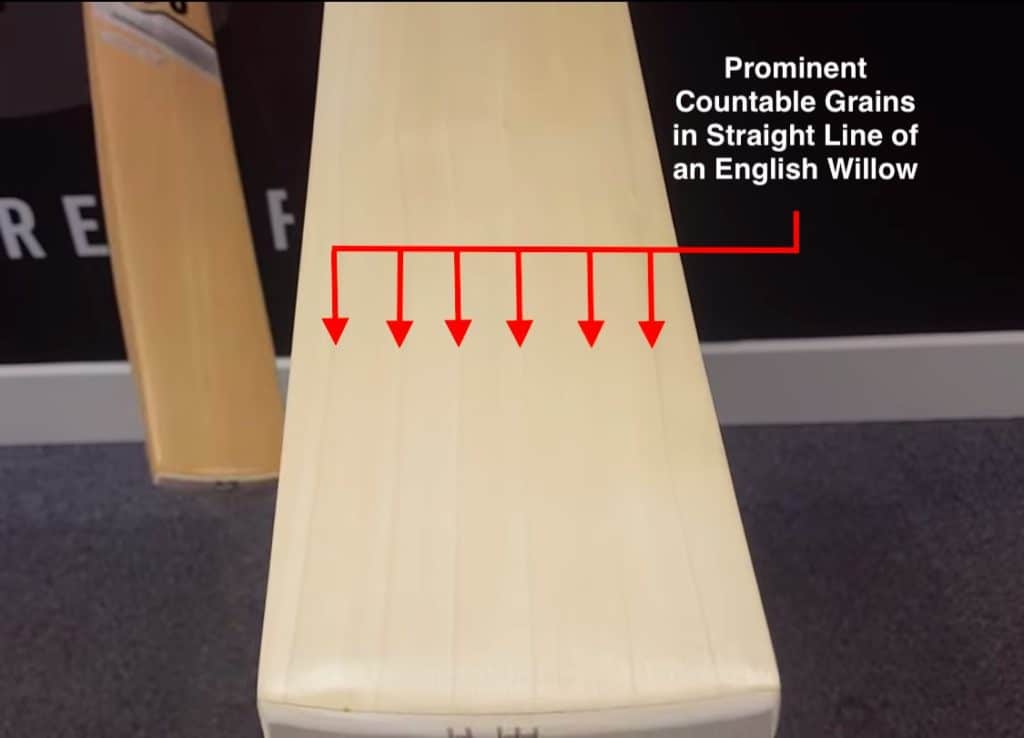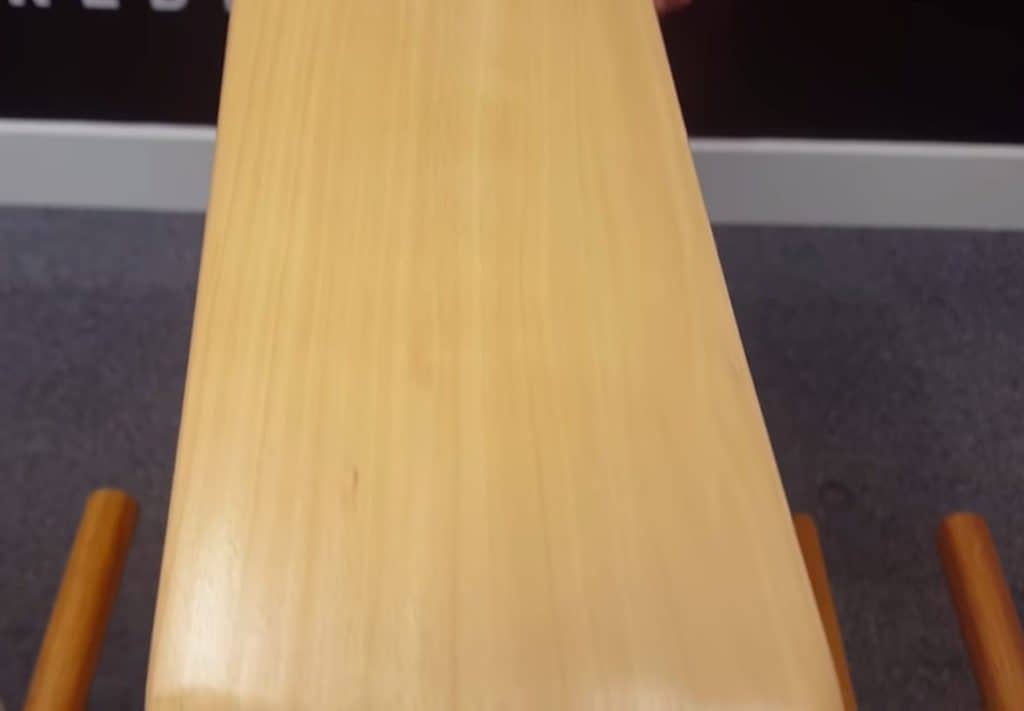Buying a good cricket bat can be an expensive affair! Thus, it is of utmost importance that we understand the nuances of a good cricket bat such as the grains on a cricket bat. Why are there any grains on a cricket bat? What do these grains signify? In this post, we will understand the details about the grains on a cricket bat.
Grains on a cricket bat are vertical lines present naturally on a bat. A good cricket bat has about 6 to 12 grains on it. Each grain represents 1 year of growth of that particular willow tree. Number of grains have a direct correlation with the quality of the cricket bat.
So, how do you identify these grains and what else should you be aware about the grains when choosing a cricket bat? Let’s learn a bit more –
How to Identify the Grains on a Cricket Bat?
As we mentioned above, grains are nothing but vertical lines on a cricket bat. On some cricket bats, the grains or the vertical lines can be straight and easily distinguishable while on some of the other cricket bats it can be blended and not clearly recognisable.
Identifying Grains on an English Willow
A Willow is actually a type of wood used for making a cricket bat. The botanical name of the tree from which this wood comes from is Salix Alba Caerulea.
When this tree is grown in England, the bat is known to be an English Willow.
An English Willow is the highest quality cricket bat that is available in the market. It is often the most popular choice of professional cricketers. However, it is also often the most expensive cricket bat.

An English Willow has easily distinguishable and straight vertical grains on it. Identifying grains on an English Willow is a lot easier than other cricket bats.
In order to identify the grains on an English Willow, pick the bat up horizontally under the light, and you will be able to see vertical near straight lines on the bat. These are basically the grains of a cricket bat.
Identifying grains on a Kashmir Willow
Another popular type of a cricket bat is a Kashmir Willow.
When the Salix Alba Caerulea is grown in Kashmir in India, the bat made from such tree is known as a Kashmir Willow.
The quality of a Kashmir Willow cricket bat is a lot different from that of an English Willow. This is predominantly due to the difference in the environmental conditions in which the two trees are grown owing to a resulting quality difference in the type of wood.
We wrote a detailed post that helps you understand the key differences between a Kashmir Willow and an English Willow cricket bat. Be sure to read more about it!
Since Kashmir Willow is a lot cheaper than English Willow, knowing the difference between the two is really important so that you don’t end up paying for an English Willow while buying a Kashmir Willow.

The above image showcases the grains on a Kashmir Willow. As you may observe, the grains on a Kashmir Willow are often very thin and interspersed with each other. Thus, it is difficult to count the actual grains on a Kashmir Willow.
From this point onwards, we shall only be referring to an English Willow while talking about the grains on a cricket bat since the grains on a Kashmir Willow are virtually indistinguishable; thus making it irrelevant to this topic.
Is Having More Grains on a Cricket Bat Better?
Cricket bats with more grains reach their peak performance levels much faster. However, since the wood used for the bat with more grains is older than a bat with fewer grains, a cricket bat with more grains tends to break more easily.
Let’s understand this in greater detail.
You may have heard that people often say that the wood on a cricket bat is like wine – the older it is, the better the quality!
Some English Willow cricket bats have fewer grains. There can be as few as 4 – 5 grains. While some other English Willow cricket bats may have more grains in the range of 12 – 15 grains!
Since the grains represent 1 year of growth of that particular willow tree, is it fair to say that having more grains on a cricket bat is better? Well, this is not necessarily true. Having a lot of grains on a cricket bat is not necessarily a good thing.
To understand this, we first need to understand why a cricket bat has more grains.
Why Do Some Cricket Bats have More Grains than Others?
Sometimes, an English Willow tree grows much slower than other English Willow trees. In such cases, the thickness of the bark of the tree is lower than the average. This means a tree that grows slowly over a period of 10 years will have a much thinner bark as compared to other trees growing at a moderate rate.
As a result, wood taken for making a bat from this tree will have more number of grains.
Since the tree grew slowly, the fibres of the wood are also more compact and tightly packed. This makes the wood hard. Therefore, bats made from such wood are hard and also often need less knocking.
However, such bats that have more grains on it are more brittle and break easily.
Thus, having more grains on a cricket bat doesn’t necessarily mean that it is a better cricket bat.
Narrow Grains vs Wide Grains – Which Cricket Bat is Better?
The grains on a cricket bat should not be too narrow or too wide. Having very narrow grains on a cricket bat can mean that the bat may break easily whereas having really wide grains may mean that the bat may take a long time to reach peak performance. On average, a cricket bat should have about 6 to 12 grains.
The reason a cricket bat has narrow grains is that the tree from which the bat is made grows slowly as compared to other willow trees. Due to the narrow nature of the grains, a cricket bat may have more number of grains.
As explained in the previous point, a cricket bat with more grains may be useful if you need to reach peak performance. However, the disadvantage of a bat with narrow grains is that they tend to break easily. Furthermore, since the wood is densely packed on such bats, they tend to be on the heavier side.
On the contrary, a cricket bat with wide grains tends to have fewer grains on it. The fibres and particles in this type of wood are further apart making. Thus, cricket bats with wide grains tend to be lighter.
Furthermore, cricket bats with wide grains are softer in nature due to the loosely packed fibres. They require a lot of knocking initially, and take time to reach peak performance. Once the peak performance is reached, it can last really long with proper care and maintenance of the bat.
Do Grains Affect the Willow Grade?
The grains on a cricket bat are definitely a contributing factor to the Willow Grade. However, in order to determine the grade of willow, there are several factors that are considered. A grade 1 willow often tends to have a higher number of grains in it.
However, simply having higher number of grains doesn’t necessarily qualify it as a higher grade cricket bat.
There are several factors that are considered when classifying a grade of a cricket bat. A Grade 1 willow is usually the most pristine-looking cricket bat with little or no blemishes. Other lower grades of a cricket bat can include blemishes such as a pink knot, speck, butterfly stains, or even dead knots.
1 TIP for Choosing a Good Cricket Bat
There are several factors which influence your decision when buying a cricket bat. However, when it comes to choosing the number of grains, an easier way to choose a cricket bat is to a bat with at least about 5-6 grains.
Do remember that choosing a cricket bat with higher grains may not last a long time.
